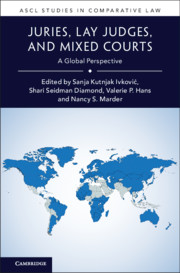Book contents
- ASCL Studies In Comparative Law
- Juries, Lay Judges, and Mixed Courts
- Copyright page
- Contents
- Editors
- Contributors
- Acknowledgments
- 1 Introduction
- Part I Advances in Lay Participation
- Part II Enduring Systems of Lay Participation
- 7 “… And My Right”
- 8 “In the Name of the People”
- 9 The Jury in Canada
- Part III Challenges to Lay Participation in Law
- Part IV Global Perspectives on Lay Participation
- Name Index
- Subject Index
- References
8 - “In the Name of the People”
Lay Assessors in Germany
from Part II - Enduring Systems of Lay Participation
Published online by Cambridge University Press: 03 August 2021
- ASCL Studies In Comparative Law
- Juries, Lay Judges, and Mixed Courts
- Copyright page
- Contents
- Editors
- Contributors
- Acknowledgments
- 1 Introduction
- Part I Advances in Lay Participation
- Part II Enduring Systems of Lay Participation
- 7 “… And My Right”
- 8 “In the Name of the People”
- 9 The Jury in Canada
- Part III Challenges to Lay Participation in Law
- Part IV Global Perspectives on Lay Participation
- Name Index
- Subject Index
- References
Summary
Lay participation is part of Germany’s legal system. Lay assessors, who are ordinary citizens, serve alongside professional judges on mixed tribunals. This chapter focuses on criminal courts that use lay assessors. We find that lay assessors indeed contribute to the work of the German criminal courts. Lay assessors are most active during deliberations, especially if the presiding professional judge accepts them as partners with equal rights. Most laypersons report a positive experience, and indeed, most professional judges sitting on mixed tribunals support lay participation. German court culture encourages lay assessors and professional judges to reach a consensual decision rather than taking a formal vote. The chapter suggests several reforms that would enable lay assessors to play a more active role on mixed tribunals.
Keywords
- Type
- Chapter
- Information
- Juries, Lay Judges, and Mixed CourtsA Global Perspective, pp. 152 - 173Publisher: Cambridge University PressPrint publication year: 2021

